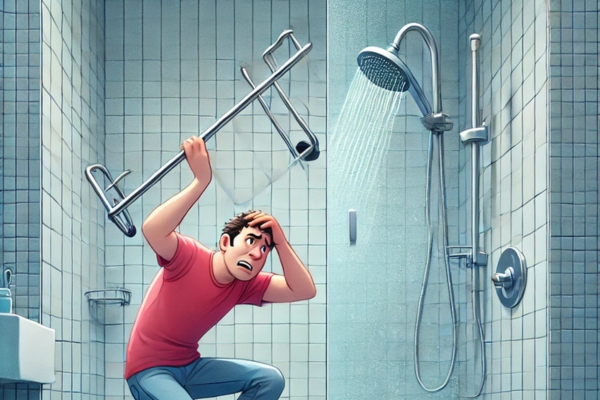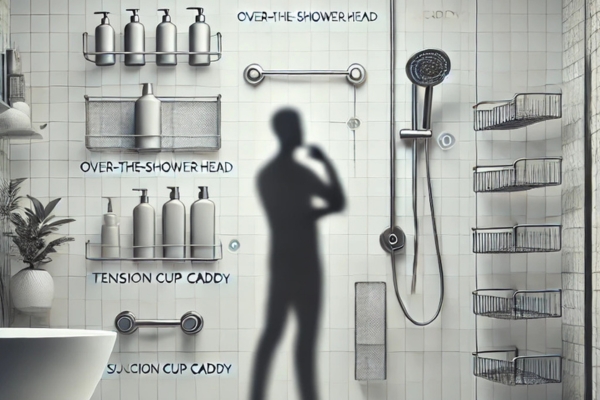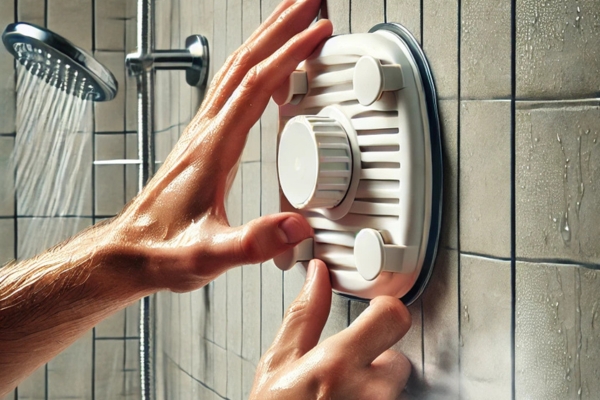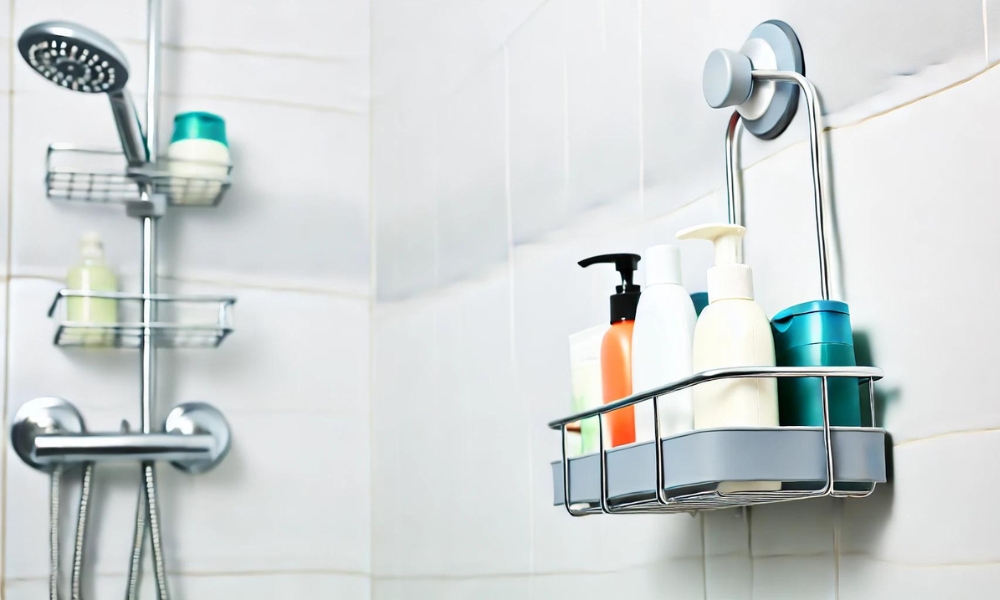Morning routines are meant to be peaceful, almost meditative. Yet, nothing disrupts that tranquil start more than a shower caddy that continuously plummets from its perch. Reaching for your shampoo or grabbing a loofah becomes a delicate balancing act. That sudden crash? It’s more than just an annoyance—it’s a chaotic start to your day. But what if that frustration could vanish with a few strategic adjustments? Let’s dive into how to keep that shower caddy from falling, ensuring stability, order, and—most importantly—your sanity.
Importance Of A Secure And Stable Shower Caddy Setup
A stable shower caddy does more than just store your essentials. It protects your bathroom from unnecessary clutter and accidents. Have you ever slipped on a fallen bottle of conditioner or witnessed your tiles scratched by crashing metal? A secure setup is vital not just for cleanliness but also for safety. When your holder holds firm, you can focus on your self-care routine, uninterrupted. Moreover, a well-placed caddy enhances the overall organization of your space, preventing everything from slipping into disarray.
Why Does Your Shower Caddy Keep Falling?
There’s no single reason for a falling shower caddy—there are many. Suction cups, a popular method of attachment, tend to weaken over time, especially in high-moisture environments like bathrooms. Sometimes, the surface beneath the holder isn’t completely smooth, causing those cups to lose their grip. And then, there’s the issue of weight. Overloading your caddy with heavy bottles? It’s like expecting a paper airplane to carry a brick. Materials also play a significant role; lightweight, flimsy caddies bend or sag over time, losing their once-pristine structure.
Common Challenges Of Installing Shower Caddies

Installing a shower caddy seems straightforward, but anyone who’s struggled with a misbehaving one knows better. High humidity, slippery surfaces, and odd shower layouts can create significant challenges. It’s not just about getting the caddy to stick—it’s about making it stay. Misalignment, over-tightening, or simply choosing the wrong caddy for your space can exacerbate issues, turning a simple task into a battle of persistence. Understanding these barriers helps prevent long-term frustration.
Understanding The Different Types Of Shower Caddies
Not all shower caddies are created equal. You’ll find various designs, each with distinct pros and cons. Over-the-showerhead caddies, for example, are popular for their simplicity but may shift or tilt if not properly balanced. Suction cup caddies? Great for smooth surfaces but prone to losing their hold. For more permanence, tension rod caddies offer reliable support, thanks to their spring-loaded mechanism. Adhesive-based caddies cater to smaller spaces, but their longevity depends heavily on proper installation. The trick is picking the right one for your needs.
Choosing The Right Shower Caddy For Your Bathroom

Your shower isn’t like anyone else’s. It has its unique quirks, corners, and limitations. So, when choosing a holder, think beyond aesthetics. Is there enough space for a hanging caddy, or will a tension rod fit better in a corner? Material matters too—plastic is rust-resistant and lightweight, while metal is sturdier but might corrode over time. How much weight will you be asking your caddy to hold? Make these considerations carefully, blending function with design to create an effective storage solution.
Why Shower Caddies Fall: Common Causes
The villain behind your falling caddy? It could be air trapped beneath suction cups or a dirty wall surface. Dirt, moisture, and even temperature changes play a role in reducing the effectiveness of suction. Adhesive caddies suffer from similar problems—too much humidity and they start to peel off. Overloading your caddy with excessive weight is another sure way to watch it come tumbling down. Identifying the root cause allows you to fix the issue at its core, instead of dealing with repeat collapses.
How To Attach Shower Caddy To Tile
Attaching a shower caddy to tile requires careful preparation to ensure a secure and lasting hold. Begin by thoroughly cleaning the tile surface with a mild cleaner to remove any soap scum, dirt, or residue, as a clean surface enhances suction or adhesive grip. For suction cup caddies, ensure the tiles are completely smooth and dry before pressing the cups firmly against the surface, eliminating any air bubbles for a stronger seal. If you’re using an adhesive-based holder, apply the adhesive strips or pads to the back of the caddy, then press it against the tile, holding it in place for a few minutes to ensure maximum adhesion. For tension rod caddies, adjust the rod to the proper height and twist to tighten it securely between the floor and ceiling or wall to wall, making sure it’s stable and balanced.
How To Hang A Shower Caddy On The Wall
Hanging a shower caddy on the wall involves selecting the right type of caddy and ensuring proper installation for a secure fit. Start by choosing a wall-mounted holder with either adhesive strips or screws, depending on your preference and the wall material. For adhesive-based caddies, clean the wall thoroughly to remove any moisture or residue, then apply the adhesive backing to the holder and press it firmly against the wall, holding it in place for a few minutes to ensure it sticks well. If you prefer a screw-mounted option, mark the desired spots on the wall, drill small holes, and insert wall anchors before securing the caddy with screws. Make sure the holder is level and properly balanced to avoid any shifting or falls, and arrange items in a way that evenly distributes weight.
Preparing Your Shower Surface For A Better Hold
A clean slate is key. Soap scum, water stains, and even natural oils prevent suction cups or adhesives from properly sticking. Start with a thorough scrub of your chosen surface—eliminate all residue. Once clean, dry the area meticulously. Even a tiny droplet can interfere with adhesion. A dry cloth buff can go a long way in ensuring a firm grip. This simple preparation creates a solid foundation for your caddy, reducing the likelihood of future slippage.
Using Suction Cups Effectively To Prevent Falls

Suction cups are both a blessing and a curse. When used correctly, they can hold strong; misuse them, and they’re a liability. To maximize their effectiveness, dip the cups in warm water before application—this softens the rubber, enhancing suction. Ensure the surface is smooth and flat, and press down with enough force to eliminate air bubbles. Reapply every few months, as suction naturally weakens over time. With the right care, suction cups can be a reliable method of keeping your caddy secure.
Installing A Tension Rod Shower Caddy For Maximum Stability
Tension rod caddies are the champions of the shower storage world. Their pressure-based setup provides unbeatable stability. Start by adjusting the rod’s length so it fits snugly between the floor and ceiling of your shower (or wall to wall in certain designs). Once positioned, tighten the rod until it’s immovable. Ensure an even weight distribution across the caddy shelves—heavier items should sit lower, creating balance. With proper installation, a tension rod holder is practically unshakeable.
Ensuring Adhesive-Based Caddies Stay In Place
For small showers or renters avoiding drill holes, adhesive caddies are a perfect choice. But they require careful handling. Before sticking the caddy to the wall, clean and dry the surface meticulously. Press the adhesive pads firmly against the wall, holding them for a few minutes to guarantee a strong bond. Keep an eye on humidity levels—high moisture can degrade the adhesive over time, meaning occasional replacement might be necessary. Done right, these caddies offer sleek, secure storage.
Balancing Weight Distribution In Your Caddy
Weight distribution is key to caddy stability. Start by placing heavier items like large shampoo bottles or conditioners on the bottom shelf. Lighter items, such as soap or razors, should be positioned higher up. This prevents the holder from becoming top-heavy and tipping over. Regularly decluttering your holder also helps—get rid of empty bottles and excess items to reduce strain and maintain balance.
Adding Anti-Slip Features To Your Shower Caddy
You can take matters into your own hands by adding anti-slip features to your caddy. Rubber grips or adhesive pads placed under the caddy’s base prevent sliding, even when wet. A non-slip shower mat provides an additional layer of security, catching items that might otherwise fall. With these subtle modifications, your holder gains a stronger foothold, reducing the risk of accidents.
Periodic Maintenance Tips To Keep Your Caddy Secure
Like any household item, shower caddies benefit from periodic maintenance. Check suction cups, adhesive strips, or tension rods for wear and tear. Clean the caddy regularly to avoid the buildup of soap scum, which can cause components to weaken. If you notice signs of deterioration, such as peeling adhesive or warping metal, it’s time to replace or repair those parts to keep your holder functional.
Alternative Storage Solutions If Your Caddy Keeps Falling
If traditional shower caddies just aren’t cutting it, alternative storage solutions might be worth exploring. Wall-mounted shelves provide a permanent fix and are ideal for larger bathrooms. Built-in shower niches offer a sleek, custom design that keeps your essentials off the floor. Waterproof baskets or hooks are another easy-to-install option, helping you keep your shower organized without the frustration of a falling caddy.
Understanding When It’s Time To Replace Your Shower Caddy
Nothing lasts forever, including your shower caddy. Suction cups lose their elasticity, metal caddies rust, and adhesives degrade. When you notice your holder constantly falling despite repeated fixes, it may be time to upgrade. Newer models often boast improved designs, stronger materials, and better adhesion technologies. Don’t hesitate to replace your old caddy—it’s an investment in a more organized bathroom.
Creative DIY Solutions To Keep Shower Caddies Secure
DIY enthusiasts rejoice! Reinforcing a shower caddy can be both fun and effective. Zip ties offer an extra layer of security for over-the-showerhead caddies. Double-sided adhesive tape strengthens suction cups that are starting to lose their grip. Creative solutions like rubber bands or additional hooks can provide additional support, keeping your caddy in place without a fuss.
Product Recommendations For Shower Caddy Security
Need a new caddy? There are several excellent brands to consider. OXO’s suction cup models are built to withstand moisture while maintaining a firm grip. For tension rod solutions, Simplehuman offers durable, rust-resistant designs that stand the test of time. Umbra’s adhesive-based caddies are sleek, functional, and ideal for small spaces. Investing in a quality brand ensures fewer frustrations down the line.
Why Does My Suction Cup Keep Falling?
Suction cups often fail because of trapped air, debris, or excess moisture between the cup and the wall. Over time, the rubber material hardens, reducing its ability to create a strong seal. Regular cleaning of the suction cups and wall surface, along with occasional reapplication, helps maintain a better grip.
How Can I Remove A Stubborn Adhesive?
Removing adhesive residue from shower walls can be frustrating. Start by soaking the adhesive in warm water, which softens it and makes removal easier. Use a plastic scraper to gently lift the adhesive off the wall. For extra-stubborn residue, rubbing alcohol or adhesive remover works wonders, dissolving the adhesive without damaging your shower walls.
What Should I Do If My Caddy Keeps Tilting?
A tilting caddy often signals poor weight distribution. Heavier items should always be placed at the bottom to create a solid foundation. If the holder is attached to the wall, check that it’s level and secure any loose screws or fasteners. A small adjustment can restore balance and stability.
Final Thoughts
Keeping your shower caddy from falling doesn’t require complex tools or expertise—just a bit of attention to detail. Whether it’s balancing weight, cleaning surfaces, or choosing the right type of caddy, a stable setup can transform your shower experience. With these simple adjustments, you can wave goodbye to falling caddies and hello to a clutter-free, stress-free bathroom routine.


